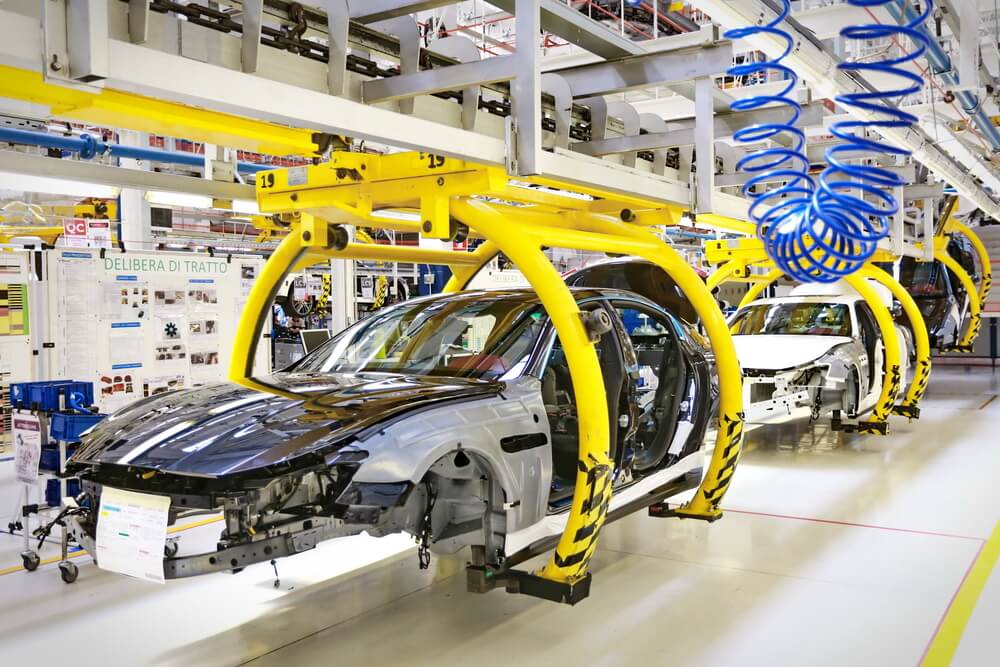Revving Up the Road A Breakdown of Mexico’s Automotive Industry in 2015

Mexico automotive industry in 2015 has come a long way since its inception. Over the years, it has experienced significant growth and development, transforming itself into a global powerhouse. The industry’s success can be attributed to several key factors, including trade agreements, affordable labor costs, and a strategic geographic location.
One of the major turning points for Mexico automotive industry in 2015 was the signing of the North American Free Trade Agreement (NAFTA) in 1994. Under this agreement, trade barriers between Mexico, the United States, and Canada were significantly reduced, allowing for the seamless flow of goods and services across borders. This opened up new opportunities for foreign investment and collaboration, propelling Mexico’s automotive industry onto the international stage.
Another crucial factor in the industry’s growth is Mexico’s competitive labor costs. With wages lower than those in the United States and Europe, manufacturers found it cost-effective to set up production facilities in Mexico. This led to an influx of automotive companies, both established players and new entrants, seeking to take advantage of the country’s skilled workforce and cost savings.
Mexico’s strategic geographic location has also played a pivotal role in the development of its automotive industry. Situated in close proximity to the United States, one of the largest automotive markets in the world, Mexico offers manufacturers easy access to customers and suppliers. This geographical advantage, coupled with an extensive transportation infrastructure, has made Mexico an ideal location for automotive production and distribution.
The growth of Mexico’s automotive industry has been nothing short of remarkable. In 2014, the country overtook Brazil as the largest automotive producer in Latin America. According to data from the Mexican Association of the Automotive Industry (AMIA), the industry’s production reached a record-breaking 3.6 million vehicles in 2015, a 6.7% increase compared to the previous year. This impressive growth has solidified Mexico’s position as a global automotive manufacturing hub.
Key Players in Mexico’s Automotive Industry
Contents
Mexico’s automotive industry is home to several key players, both domestic and international, who have contributed to its growth and success. These companies have established a strong presence in the country and are driving innovation, investment, and job creation.
One of the prominent players in Mexico automotive industry association is Nissan. The Japanese automaker has been manufacturing vehicles in Mexico since 1966 and has invested heavily in the country. Nissan’s production facilities in Aguascalientes and Cuernavaca are among the largest in the country and have a combined annual production capacity of over 800,000 vehicles. The company’s commitment to Mexico is evident through its continuous investment in new technologies and the expansion of its manufacturing capabilities.
Another major player in Mexico’s automotive industry is General Motors (GM). With several manufacturing plants across the country, GM has a significant presence in Mexico. The company produces a wide range of vehicles, including sedans, SUVs, and pickup trucks, for both domestic and international markets. GM’s investment in Mexico has not only contributed to the country’s economic growth but has also created numerous job opportunities for Mexican citizens.
Volkswagen is also a key player in Mexico’s automotive industry. The German automaker has been manufacturing vehicles in the country since the 1960s and has established a strong foothold. Volkswagen’s production facility in Puebla is one of the largest automotive plants in the world and has a production capacity of over 450,000 vehicles per year. The company’s commitment to Mexico is evident through its continuous investment in research and development, as well as its focus on sustainability and environmental initiatives.
In addition to these global players, Mexico’s automotive industry is home to several domestic manufacturers, such as Grupo Kuo and Nemak. These companies have played a crucial role in driving innovation and promoting local talent. Their contributions have not only strengthened Mexico’s automotive industry but have also enhanced the country’s reputation as a global automotive manufacturing hub.
Manufacturing and Production in Mexico’s Automotive Industry
Mexico’s automotive industry is known for its robust manufacturing and production capabilities. The country has a well-developed supply chain ecosystem, which includes not only vehicle assembly but also the production of components and parts.
The manufacturing process in Mexico’s automotive industry typically involves several stages. First, the production of components and parts takes place, either by domestic suppliers or through imports. These components are then sent to assembly plants, where they are combined to create the final product – the vehicle. The assembly plants, also known as original equipment manufacturers (OEMs), are responsible for ensuring the efficient and timely production of vehicles.
Mexico’s automotive industry has a diverse manufacturing landscape, with different OEMs specializing in various types of vehicles. Some manufacturers focus on passenger cars, while others specialize in commercial vehicles, such as trucks and buses. This diversity allows Mexico to cater to a wide range of customer demands and expand its market presence.
The country’s manufacturing capabilities are not limited to vehicle assembly. Mexico also has a strong presence in the production of automotive components and parts. Several domestic and international companies have set up manufacturing facilities in Mexico to produce components such as engines, transmissions, and electrical systems. This integrated approach to manufacturing has further strengthened Mexico’s position as a global automotive manufacturing hub.
The production output of Mexico’s automotive industry has been steadily increasing over the years. According to data from AMIA, the country produced over 3.6 million vehicles in 2015, a significant increase compared to previous years. This growth can be attributed to the continuous investment in manufacturing infrastructure, the availability of skilled labor, and the strong support from the government.
Mexico’s Automotive Exports and Imports
Mexico’s automotive industry has emerged as a major exporter of vehicles and automotive components. The country’s strategic geographic location and trade agreements have allowed it to access global markets and establish strong trade relationships with other countries.
In 2015, Mexico exported over 2.8 million vehicles, making it the fourth-largest exporter of vehicles in the world. The majority of these exports were destined for the United States, which has been a key market for Mexican-made vehicles. Mexico’s proximity to the United States, coupled with its competitive labor costs, has made it an attractive destination for automotive manufacturers seeking to serve the American market.
In addition to vehicle exports, Mexico is also a significant exporter of automotive components and parts. The country’s robust manufacturing capabilities allow it to produce a wide range of components, including engines, transmissions, and electrical systems. These components are exported to various countries around the world, further cementing Mexico’s position as a global automotive manufacturing hub.
While Mexico is a major exporter of vehicles and components, it also imports a significant amount of automotive products. The country imports vehicles and components to meet domestic demand and to supplement its manufacturing capabilities. This import-export dynamic has contributed to the growth and development of Mexico’s automotive industry, fostering collaboration and trade relationships with other countries.
Overall, Mexico’s automotive industry’s export and import activities have played a crucial role in its growth and success. The industry’s ability to access global markets, establish strong trade relationships, and meet customer demands has positioned Mexico as a key player in the global automotive landscape.
Government Policies and Incentives for the Automotive Industry in Mexico
Mexico’s automotive industry has received strong support from the government through various policies and incentives. These measures have played a crucial role in attracting foreign investment, promoting domestic manufacturing, and driving the industry’s growth and development.
One of the key government policies that have benefited the automotive industry is the establishment of free trade agreements. Mexico has signed several trade agreements with countries around the world, including the United States, Canada, and the European Union. These agreements have reduced trade barriers and facilitated the seamless flow of goods and services across borders, allowing automotive manufacturers to access global markets more easily.
To further incentivize investment in the automotive sector, the Mexican government has implemented various tax incentives and benefits. For example, the Maquiladora program allows companies to import raw materials and components duty-free for manufacturing purposes. This program has been particularly beneficial for automotive manufacturers, as it helps reduce production costs and increase competitiveness.
The government has also invested in infrastructure development to support the automotive industry. This includes the construction and improvement of transportation networks, such as highways and railroads, to facilitate the movement of goods and materials. Additionally, the government has invested in the development of industrial parks and manufacturing clusters, providing automotive companies with specialized infrastructure and resources.
In recent years, the Mexican government has also focused on promoting research and development (R&D) in the automotive industry. Through various initiatives and partnerships with academic institutions and industry players, the government aims to enhance competitiveness and foster innovation. These efforts have resulted in the development of new technologies and the advancement of Mexico’s automotive manufacturing capabilities.
The government’s commitment to supporting the automotive industry is evident through its continuous efforts to create a favorable business environment. By implementing policies and incentives that attract foreign investment, promote domestic manufacturing, and foster innovation, the government has played a crucial role in the growth and success of Mexico’s automotive industry.
Challenges and Opportunities in Mexico’s Automotive Industry
While Mexico automotive industry in 2015 has experienced remarkable growth and success, it also faces several challenges and opportunities that will shape its future.
One of the challenges for Mexico’s automotive industry is the need to develop a skilled workforce. With the industry’s continuous growth and technological advancements, there is a growing demand for skilled labor. To address this challenge, the government and industry players are investing in vocational training programs and collaborations with educational institutions. These initiatives aim to equip the workforce with the necessary skills and knowledge to meet the industry’s evolving needs.
Another challenge is the need for sustainable and environmentally friendly practices. As the automotive industry continues to expand, there is a growing concern about its environmental impact. To address this challenge, automotive companies in Mexico are investing in research and development of alternative fuels, electric vehicles, and other eco-friendly technologies. These efforts not only contribute to sustainability but also present new business opportunities for the industry.
Mexico automotive industry in 2015 also faces the challenge of maintaining its competitiveness in the global market. As other countries, including China and India, emerge as strong contenders in the automotive industry, Mexico needs to continuously innovate and improve its manufacturing capabilities. This requires investment in technology, research and development, and collaboration with industry players to stay ahead of the competition.
Despite these challenges, Mexico’s automotive industry also presents significant opportunities for growth. The country’s strategic geographic location and trade agreements provide access to global markets, allowing automotive companies to expand their customer base. Furthermore, the continuous investment in infrastructure and the government’s support through policies and incentives create a favorable business environment.
Mexico automotive industry in 2015 also benefits from the growing demand for vehicles in emerging markets. As countries like Brazil, India, and China experience economic growth and rising middle-class populations, the demand for vehicles is expected to increase. This presents an opportunity for Mexican automotive manufacturers to tap into these markets and expand their global footprint.
Mexico automotive industry in 2015 has experienced remarkable growth and development in recent years. The industry’s success can be attributed to several factors, including trade agreements, competitive labor costs, and a strategic geographic location. Key players, both domestic and international, have contributed to the industry’s growth and success through investment, innovation, and job creation. Government policies and incentives have played a crucial role in attracting foreign investment, promoting domestic manufacturing, and driving the industry’s growth. Despite challenges, the industry presents significant opportunities for growth, driven by access to global markets and the growing demand for vehicles in emerging economies. Mexico’s automotive industry is revving up the road and poised for continued success in the future.





